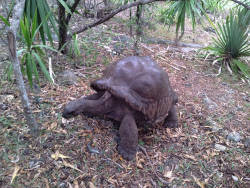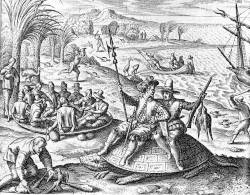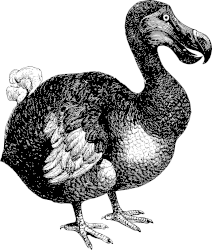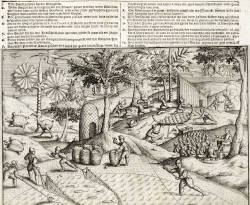François Leguat Giant Tortoise and Cave Reserve
Grande Caverne
Useful Information


| Location: |
Rodrigues, Mauritius.
In the south west of the island, Plaine Corail.
Take the road to Plaine Corail, turn left at Cascade Jean Louis.
(-19.757834, 63.370690) |
| Open: |
All year daily 9-17. tours 9:30, 10:30, 13:30, 14:30. [2021] |
| Fee: |
Adults EUR 15, Children (2-12) EUR 8, Children (0-1) free. [2021] |
| Classification: |
 Karst Cave Karst Cave
|
| Light: |
 LED LED
|
| Dimension: | L=100 m. |
| Guided tours: | L=100 m, D=60 min. V=50,000/a [2019] |
| Photography: | allowed |
| Accessibility: | no |
| Bibliography: |
François Leguat (1891):
The voyage of François Leguat of Bresse, to Rodriguez, Mauritius, Java, and the Cape of Good Hope
London : Printed for the Hakluyt Society, 1891.
David A Burney (2011): Rodrigues Island: Hope thrives at the François Leguat Giant Tortoise and Cave Reserve, Madagascar Conservation & Development. Volume 6, Issue 1, June 2011. pp. 3-4. Madagascar Conservation & Development researchgate |
| Address: |
Anse Quitor, Rodrigues Island, Via Mauritius Island, Indian Ocean, Tel: +230-8328-141.
E-mail: |
| As far as we know this information was accurate when it was published (see years in brackets), but may have changed since then. Please check rates and details directly with the companies in question if you need more recent info. |
|
History
| 1730-1770 | estimated 280,000 tortoises were taken away on ships or killed for meat and oil. |
| 1980s | Mauritian Wildlife Foundation started to save what is left of Rodrigues’ native flora. |
| 2005 | reforestation project started, planting 300,000 seedlings of 40 native species in the Reserve. |
| 2006-2007 | Francois Leguat Ltd re-introduced two species of tortoises (Aldabra and Radiated Tortoises) that are the closest living tortoise species to the extinct Rodrigues tortoises. |
Description


François Leguat Giant Tortoise and Cave Reserve is - as the name says - primarily a reserve to protect the endangered giant tortoises. It was named after François Leguat (1637–1735), the island’s first resident. Leguat and seven other Huguenots were exiled on the island by the French government in 1608. They built a boat and sailed to Mauritius where they were interned on an island for another 6 years. The reason why he was chosen, is the fact that he was a keen observer of the island’s wildlife and produced the only illustration of the solitaire bird and the only description of its behaviour.
It is a 20 ha reserve with tropic birds and tens of thousands of native trees. And it happens to have a cave named Grande Caverne on its ground, which is a huge passage with elevated trails and electric light. Actually the park features nine impressive caves and dolines, but this is the one which was developed for visitors. It is said to be the only electrified "Show Cave" in the south West Indian Ocean and they are quite proud that all was done to international standards with the help of an Australian cave consultant (obviously Greg Middleton). Actually the cave is very well and carefully developed and the Australian Karst Conservancy has a very good reputation.
The center is located on a plain called Plaine Corail, an kilometer east of the small airport of the island. As the name says, the rocks of this plain are coral limestones, which is quite exceptional on the otherwise volcanic island Rodrigues. The limestone is karstfied and there are numerous caves, like the Caverene Bambara, the Caverne La Vierge, and the Grande Caverne. They are all different parts of the same cave system, which were separated by the collapse. The vast main passage was rather close to the surface, a 325 m long part of the passage has collapsed and forms now a gorge named Canyon Tiyel. The former cave walls are now the walls of the gorge.
The tour starts at the entrance building, which also has a shop and a restaurant. If you are too early, you can spend some time in the informative museum which is dedicated to both, the turtles and the caves. On the tour the visitors enter the gorge, which is a secluded sanctuary for the giant turtles. The guided tour first allows to see the turtles in the gorge, then enters the cave through the huge portal. Visitors are equipped with fine red helmets, which is completely unnecessary, but seems to be expected by the visitors.
A few hundred years ago Rodrigues had the highest density of land tortoises on earth. Rodrigues had two endemic species and humans started to hunt them for meat and oil after the island was discovered. In only 40 years, between 1730 and 1770 estimated 280,000 tortoises were taken away on ships or killed. After 100 years both species were extinct. The Aldabra and Radiated Tortoises are the closest living tortoise species to the extinct Rodrigues tortoises. They were born and raised at La Vanille Nature Park in Mauritius and then re-introduced by Francois Leguat Ltd in 2007 and 2008. This was so successful that today there are more than 3000 individuals. Under an agreement with the Government of Madagascar recently a third species, the Ploughshare Tortoise has been introduced. The idea is to breed them with the hope of eventually returning them to Madagascar. In their natural habitat in Madagascar this species is almost extinct due to illegal pet trade.
A major part of the protection of the turtles is to provide a natural habitat. The native forest was burnt off by tortoise hunters and for agriculture. Goats, deer and cattle was introduced and overgrazed the island. To compensate, exotic plants were introduced by the settlers, which spread rapidly. Less than 0.5% of the original native forest survived and is in a highly degraded state. And the settlers brought rats, cats and pigs with them, which ate the young and eggs of native birds and reptiles. The reserve has planted over 275,000 seedlings of 40 native species. The goal are 300,000 seedlings, and with the help of the Critical Ecosystem Partnership Fund (CEPF) it will be achieved soon. The native plants survived in remote and inaccessible areas such as on cliff faces. However, the Solitaire, a huge flightless bird which is the closest relative to the Dodo, did not survive. But other native birds and fruit bats are increasing in number.
- See also
 Search DuckDuckGo for "François Leguat Giant Tortoise and Cave Reserve"
Search DuckDuckGo for "François Leguat Giant Tortoise and Cave Reserve" Google Earth Placemark
Google Earth Placemark François Leguat Giant Tortoise and Cave Reserve - Wikipedia (visited: 17-JUN-2021)
François Leguat Giant Tortoise and Cave Reserve - Wikipedia (visited: 17-JUN-2021) François Leguat Giant Tortoise and Cave Reserve, official website (visited: 12-JUN-2021)
François Leguat Giant Tortoise and Cave Reserve, official website (visited: 12-JUN-2021) Visit Of The Giant Tortoises Park (Rodrigues) (visited: 14-JUN-2021)
Visit Of The Giant Tortoises Park (Rodrigues) (visited: 14-JUN-2021) Francois Leguat Giant Tortoise and Cave Reserve (visited: 17-JUN-2021)
Francois Leguat Giant Tortoise and Cave Reserve (visited: 17-JUN-2021)
 Index
Index Topics
Topics Hierarchical
Hierarchical Countries
Countries Maps
Maps